Total relics are approximately 32,000 items including not less than 10,000 items from excavation of burial cultural properties that were excavated from historic sites at Deokcheon-dong, Nopo-dong, old tombs, Gimhaeeupseong in Busan, Gyeongnam area, about 10,000 purchased items, about 8,000 items of donation, about 360 collected items. At present, 1,500 items of History and Folk customs of Busan from the Prehistoric period to the present (till in1953) are mainly displayed. About 40 stone-built items such as pagoda, Buddhist statues, tombstones, etc. are displayed at the outdoor exhibition space.
A total of 19 posts. (1/2page)
-
Gilt-Bronze Standing Bodhisattva (National Treasure No. 200)
-
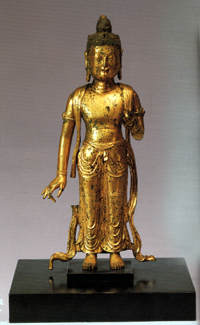
- This image of Buddha shows the superb artisanship of the Unified Silla period during the latter half of 8th century. Although the Bogwan, Daejwa and Gwangbae have been lost and part of Cheonui has been damaged, the overall appearance of the statue gives us a mild impression due to its smooth, flexible curve continued from its elbow and ample bosom to the waist though the body feels somewhat rigid. The calm smile around the mouth makes us feel the mercifulness of the statue. Especially, one of the characteristics of the statue is that it has no other decorations than the two(2) pairs of bracelets on both arms. The beautiful wrinkle of the cloths of the lower half of its body and the its rhythmical curve plays a great role in expressing the holy spirit of the statue by making the man-like commanding and solemn atmosphere smoother. The statue’s overall expression is not only true to the fact in general, with its balance and cubic effect being sufficient but has dignity and mercifulness. For this reason, it is evaluated as an excellent art piece that was made through the disposition of the craftsman in Unified Silla and mature molding skills. This statue was made of bronze and its inside is hollow. Furthermore, as the gold plating remains relatively intact, the gold color is still brilliant.
-
Yeongtaeinyeonmyeong Napseoksariraho(The Lead-stone Ash Urn with 'the 2nd Year of Yeongtae's Rule' Inscription) (National Treasure No. 233-2)
-
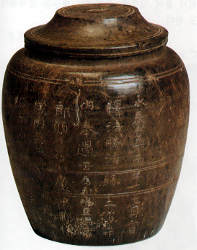
- This image of Buddha shows the supe The inscription on the surface of this ash urn reveals its exact production date is A.D. 766, and it is known to have been excavated from the jungdaeseok(central seat)on the daejwa(support), on which the stone Birojanabul is seated, at the site of a closed temple in Jirisan(mountain), Sancheong-gun, Gyeongsangnam-do. Three rows of fine lines were engraved around the surface of its body, and 15 lines of inscription (characters), each line composed of 8-11 characters, were engraved on it. The inscription reveals the production date and origin of the ash urn and the Buddha sculpture. Besides, since the inscription was made in Idu characters(Chinese characters borrowed to represent the sounds of spoken Korean), it serves as an important data for the study of language and literature, etc. as well as the Buddhist art.
-
Cheokhwabi (Busan Metropolitan City-designated Monument No.18)
-
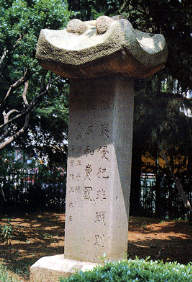
- This is a Resistance Monument Against Foreign Power that Heungsun Daewongun set up in Seoul and other important locations all over the country to resist powerful countries such as Western countries and Japan, and to reinforce national isolation and stimulate people’s awakening for it. Originally, it was set up at the Busanjin ruins of a fortress. A passage is engraved on it, which reads “Not fighting when the ‘Yangoh’ (Western Savage) invades means a compromise and it is the same as a treachery to our country. I warn this to our descendants. Made in the year of Byungin and set up in the year of Sinmi.” All of Cheokhwabi were removed after Chung Dynasty (China) kidnapped Daewongun during the Imogunran (Military Revolt in 1882, Imoh Year) and Joseon was forced to open up the door to foreigners and the trades between the countries started.
-
Yakjojechalbi (Busan Metropolitan City-designated Monument No.17)
-

- Yakjojechalbi are the monuments erected in 1683(the 9th year of Sukjong's reign) by the governors of Dongnaebu and Tsushima Islands Province to proclaim the five prohibition regulations for the operation of the waegwan. The summarized contents described therein are as shown below; 1. Anyone who comes out of the boundary prohibited to go in and out shall be sentenced to death, whether it is a major or minor violation.2. If bribery is uncovered to have given or received, both the one who gave it and the one who received it shall be sentenced to death.3. When the market opens, those who go into each other’s room to engage in a black-market business shall be sentenced to death4. When a variety of things are supplied every 5 days, the Japanese people are never allowed to drag down and beat a petty official in a provincial town, warehouse keeper, interpreter, etc.5. Both sides of criminals shall be executed to death together out of the gates of waegwan.
-
Dongnae Nammunbi (Busan Metropolitan City-designated Monument No.21)
-
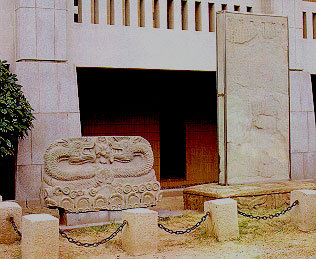
- This monument was set up outside of the Nammun (Southern gate), Mt. Nongju, which was a hard-fought field in 1670 (the 11th year of King Hyunjong’s resign), in the memory of Deputy delegate Song, Sang Hyung, who died for the country against Japanese invaders at the Dongnae Nammun (Southern gate). In 1688 (the 14th year of King Sukjong’s resign), Deputy delegate, Lee, Deok Seong made extensions. In 1709 (the 35th year of Sukjong’s reign), Deputy delegate, Yi Jin, Gwon moved it to the front yard of a detached building when he built the detached building at Chungryeol Temple. But in 1736 (the 12th year of Youngjo’s reign), as they had to remove the detached building, it had to be moved to Dongnae Nammun (Southern gate). Now it stands on the outdoor exhibition space of the municipal museum.
-
Dongnaebu Dongha-myeon archive(Busan Metropolitan City-designated Monument No.24)
-
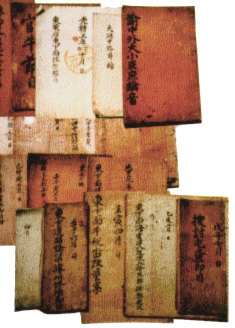
- Dongha-myeon archive is a document directly related to the local self-government administration of Dongnaebu Dongha-myeon (Part of Haeundae-gu at present) in the Joseon Dynasty. It is a very important material that informs the details of social cultural background of this region and local administration in the late Joseon Dynasty. Dongha-myun archives consist of 30 books including “Dongha-myeon family register ledger, 338 pages before 1910, and 87 pages after 1910, therefore total page is 470. It is a very valuable material in the study of history, society, and culture of Busan at the end of Joseon Dynasty. We could have a significant base in document to examine local history of Haeundae area as well as we could learn unique administration matters or civil condition that we could not find out from the Dongnaebueupji or the Japanese settlement.
-
Fishing hook at Beombang Shell Mound
-
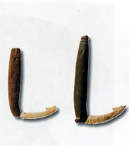
- A combination type of fishing hook that was found at Beombang-dong, Gangseo-gu is a hook of bone, which connects a fishing pole made of stone. They were found in the remains of the Neolithic period sites such as Yangyang-gun, Osan-ri, and Gangwon-do, which show a fishing history during the Neolithic period. There are 2-4 grooves on the top of an axis that enable to bind fishing wires.
-
Chrysanthemum Pattern celadon porcelain inlaid cup with a mat
-
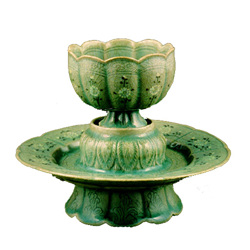
- This is a celadon porcelain cup with a mat in the middle of Goryeo. The cup and the mat are of flower shape with 10 pieces of petal. Petal on the cup saucer of the mat is of a mountain shape, and a stem of the mat is of a diaper shape. The outside is inlaid with veins and chrysanthemum patterns. Inlaid technique is originated from damascene method of metal crafts and an inlaying method of mother-of-pearl lacquer.
-
Myeongdong Bell at Angsusa(Temple), Sangju
-
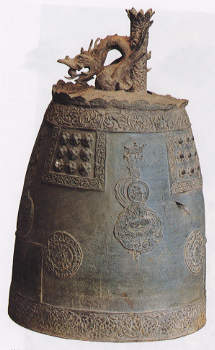
- This is a medium-sized temple bell that was reportedly unearthed around Jecheon, Chungcheongbuk-do. It has been kept relatively better than other bells of Goryeo Era. It is said that the reasons why they cast and gave it to the temple is that, after iron bell was broken, another one was made of 40 additional pounds of brass, which is inscribed on the front.And in the back names of monks and craftsmen “Yoo, Seon” was inscribed.From those inscriptions, we could recognize this is the bell of Ansusa (Temple), Sangju, Gyeongsangbuk-do. The bell is of a general shape in other temples, but the unique thing is that a seated figure of Bodhisattva is placed on between other seated figures.
-
Jade green-colored pottery inlaid Vein Pattern Changku(a double-headed drum pinched in at the middle
-
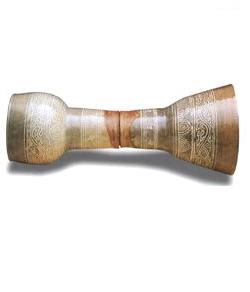
- This is Jade green-colored pottery Janggu is made as 2 parts dividing in the middle. It was used as a musical instrument with leather attached on both sides of it. One side is opened widely and the other side is narrowly pursed. The wide side is on the left, which is beaten byhand. The narrow side is on the right, which is beaten with bamboo drumstick. A light gray-blue glaze is applied all over, except for the connection part in the middle. After drawing each pattern of 2 lines for the sound body and 1 line for the axis in total 3 white inlaid lines for each, the top is inlaid with vine patterns, the bottom with lotus flower, and the other spaces with small chrysanthemum patterns.